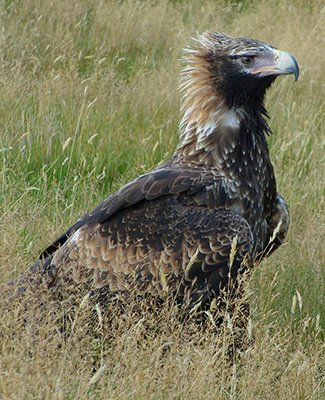Tasmanian wedge-tailed eagles are real homebodies, study finds

By looking at the genetic relationships and geographical patterns of Tasmanian wedge-tailed eagles, a University of Tasmania study has found that these birds of prey prefer to remain close to where they hatched.
Researchers Chris Kozakiewicz, Chris Burridge and Scott Carver were perplexed as to why a bird capable of long-distance flight seems to only travel on short journeys.
“We found genetic patterns that [show] they are mating close to where they hatched, or close to where they bred the year before last,” Chris Burridge said.
In addition to studying the DNA of 228 eagles, the researchers looked at whether the potential for long-distance flight was being inhibited by factors such as topography or habitat.
“The extrinsic factors were not very influential in explaining the genetic pattern that we observed,” Chris said. “It seems like factors relating to the eagles themselves, such as territorial behaviours, are governing their movements.”
Chris is currently undertaking another project that seeks to better understand how wedge-tailed eagles interact with their habitats. He said that following the findings of the recently completed study identifying these eagles as homebodies, “It’s important we make sure on a small spatial scale the eagles have what they need.”
The wedge-tailed eagle is an endangered species in Tasmania, protected by the National Parks and Wildlife Act.
Eric Woehler, Convenor of Birdlife Tasmania told Australian Geographic that the results from the recent study are critical to appropriate management of the species. “We need such data to manage the Tasmanian landscape and our land-use practices to ensure this magnificent species will persist into the future.” he said. “Dramatic words, but with so few eagles remaining in Tasmania, we need to do everything to ensure their survival.”
A 2013 University of Tasmania study, also co-authored by Chris Burridge, found there is much less genetic variation than first though between Tasmanian wedge-tailed eagles and eagles that inhabit other parts of Australia.
Simon Cherriman, a Western Australia based wedge-tailed eagle expert and environmental biologist, said it’s important to keep in mind that the Tasmanian wedge-tailed eagle is considered a different sub-species.
“A slight genetic difference is unlikely to alter movement ecology but the small size of Tasmania can restrict their movements, and perhaps breeding territories containing a high abundance of food influence birds’ decisions to ‘stay close to home,” he said. “Wedge-tailed eagles on mainland Australia travel very large distances.
Five juvenile eagles satellite-tagged in WA last year moved between 250-810km during their first three weeks of dispersal. One bird flew from Perth to the Pilbara coast, a distance of 1200km, in less than a month.”


